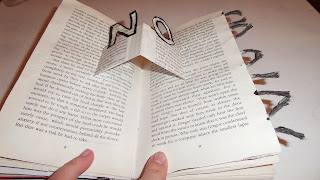Altered book
I knew that this assignment was about turning a book into a
more physical piece of work, in a very visual way. With this idea of transformation in mind,
there was really only one choice, one book with a very simple concept that is
about a transformation; Metamorphosis by Franz Kafka.
I know there are many metaphors and different readings of
this book, but the physical surprise from the very first sentence was an
impression I wanted to show in my physical interpretation.
I was also (pleasantly) surprised when I did research into
pop up books and discovered that "metamorphoses" books have been
popular from the 1880's. These books
featured a pop up technique to transform one character to another. Since this is the main concept of
Metamorphosis, I would like to try this technique among others.
I spent some time researching some different pop up
techniques and forms to include in my altered book.....
research and inspirations
http://www.youtube.com/watch?v=2PfXZilwuQM
http://www.youtube.com/watch?v=Syom89A_ops
http://www.youtube.com/watch?v=3wquaz3djM4
http://www.youtube.com/watch?v=RFIo536IZZY
http://en.wikipedia.org/wiki/Pop-up_book
A carousel book "The Little Prince" written and illustrated by Antoine De Saint-Exupery
A pop-up Picture Book " The Flyaway Fairy " illustrated by J. Samuel , written by G.Volke and paper-engineering by B.Robertson
A pop-up Picture Book "Gemini " illustrated by I. Cohen
My chosen book is " Metamorphosis" by F.Kafka
sketches
You will see from my sketches that there are a few different
styles for the 'creature'. When I read
the book, it seemed like Kafka changed the description of the creature
throughout the story, so I like the idea of my designs being a bit different.
The large pop up creature, made from a relatively simple V-Fold
mouth, is the most striking part of the book.
This is my 'big surprise' that I talked about to begin with. It is quite a simple technique but the result
is very striking. Every time I pick up
the book now, I naturally turn to this page first.
I wanted to put some hairs (or tentacles, I'm not sure which) sticking out of the pages. These help to attract attention even before the reader reads the book. They were partly inspired by the 'Monster Book of Monsters' in the Harry Potter books and films.
These pictures show my interpretation of the "metamorphoses" technique. Instead of using a tab to pull and make the change (like the traditional versions), mine is more simple and you have to pull the paper folds. I think it works just right, with odd combinations of Gregor's top and bottom halves and the creature.
This is the only physical form of text I have altered. I only wanted the word 'no' to show Gregor's despair and anger at his situation. The depth of the extra layers of paper adds a physical weight to the page, which also adds a more metaphorical depth to his pain.
I liked the effect of the wave from the 'Gemini' book at the top, I wanted to bring some movement into my book as most of my pieces have been quite static. Here I have shown the bowl full of milk that Gregor pushes away, spilling the milk on the floor.
Here are two of the 'different designs' I mentioned earlier. Here I have shown a small creature (maybe he is from a distance) behind this cellophane window. I have also designed a sort of cage bars with some string and a door. This is also a key part of the story as Gregor spends most the story behind his bedroom door.
The last piece is possibly my favourite because it gets to
the heart of the story. If Metamorphosis
was only about a scary creature it would not be as popular as it is. The heart and soul of the story is the
relationship between Gregor and his sister.
This piece uses the gutter and inner margins to show the wall that
separates them for most of the story.
There is a carpet that is the link between the two pages and the two
'worlds' within the story.





.jpg)

.jpg)
.jpg)
.jpg)
.jpg)





































